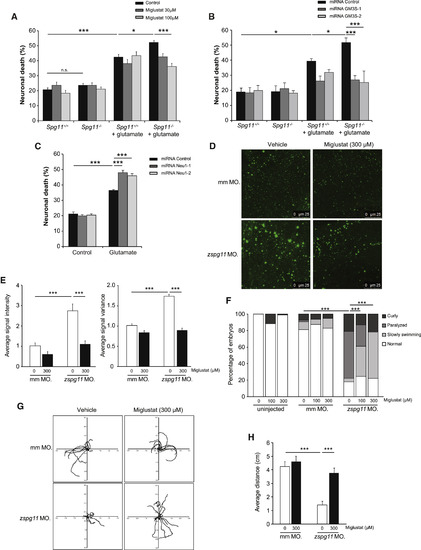- Title
-
Inhibition of Lysosome Membrane Recycling Causes Accumulation of Gangliosides that Contribute to Neurodegeneration
- Authors
- Boutry, M., Branchu, J., Lustremant, C., Pujol, C., Pernelle, J., Matusiak, R., Seyer, A., Poirel, M., Chu-Van, E., Pierga, A., Dobrenis, K., Puech, J.P., Caillaud, C., Durr, A., Brice, A., Colsch, B., Mochel, F., El Hachimi, K.H., Stevanin, G., Darios, F.
- Source
- Full text @ Cell Rep.
|
Decreasing Ganglioside Synthesis Prevents Neuronal Death and Improves Motor Dysfunction in Zebrafish Deficient for Spatacsin and Modeling SPG11 (A) Quantification of neuronal death 30 hr after incubation of neurons with glutamate (200 μM) in primary cultures of Spg11+/+ or Spg11−/− cortical neurons treated with miglustat. The graph shows the mean ± SEM values. N = 5–14 independent experiments. One-way ANOVA, followed by Holm-Sidak post hoc test; ∗p = 0.002 and ∗∗∗p < 0.001. (B) Quantification of neuronal death 30 hr after incubation of neurons with glutamate (200 μM) in primary cultures of Spg11+/+ and Spg11−/− cortical neurons transfected with vectors expressing control miRNA or two different miRNAs against GM3 synthase. The graph shows the mean ± SEM. N = 3–8 independent experiments. One-way ANOVA, followed by Holm-Sidak post hoc test; ∗p < 0.02 and ∗∗∗p < 0.001. (C) Quantification of neuronal death 30 hr after incubation of neurons with glutamate (200 μM) in primary cultures of Spg11+/+ and Spg11−/− cortical neurons transfected with vectors that downregulate Neu1 with two independent miRNAs (Neu1-1 and Neu1-2). The graph shows the mean ± SEM values. N = 6 independent experiments. One-way ANOVA, followed by Holm-Sidak post hoc test; ∗∗∗p < 0.001. (D and E) Immunostaining (D) and quantification (E) of GM2 immunostaining in the telencephalon of morphants injected with 1.2-pmol zspg11spl antisense or 1.2-pmol mismatch (mm) morpholino (MO). Injection of zspg11spl morpholino increased the mean and variance of GM2 immunostaining intensity. This phenotype was corrected when morphants were treated with miglustat. N = 6–12 morphants analyzed in each condition. One-way ANOVA; ∗∗∗p < 0.001. (F) Phenotype of morphants that were non-injected or injected with 1.2-pmol zspg11spl or 1.2-pmol mismatch (mm) morpholino. 48 hr post-fertilization, morphants were classified as normal phenotype, slowly swimming, paralyzed, or curly morphants. Injection of zspg11spl morpholino leads a large proportion of paralyzed or slowly swimming phenotypes. Treatment with miglustat decreased the proportion of paralyzed morphants. N = 102–366 morphants analyzed in each groups. Chi square test; ∗∗∗p < 0.0001. (G and H) Tracking (G) and quantification of distance traveled (H) by larvae following a touch-evoked escape response. Injection of zspg11spl morpholino impaired the swimming of morphants, which was corrected when treated by miglustat. The graph shows the mean ± SEM. N = 12 morphants analyzed in each condition. One-way ANOVA; ∗∗∗p < 0.001. See also Figure S6. |

